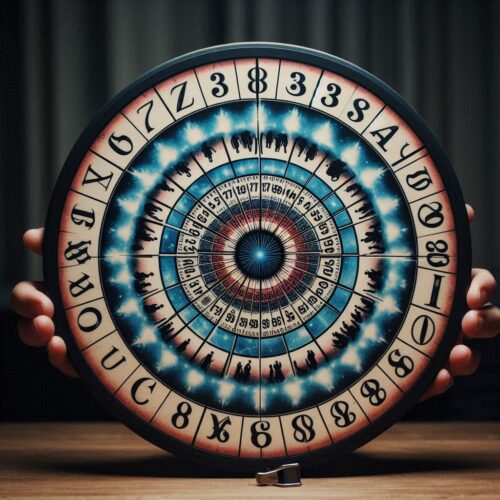Taschypsychography, or Long Distance Second Sight Magic Trick is a fascinating mentalism effect in which a mind reader, seemingly isolated from any information, reveals specific details about items handled by a committee on stage. This effect relies on a carefully arranged system of visual cues and an imaginary grid on a table, which only the performer and their assistant know about.
Taschypsychography, or Long Distance Second Sight Magic Trick
Effect
The setup involves a plain kitchen table, ten committee members from the audience, and a “mind reader” who is escorted outside the room. The committee, with the guidance of the manager, performs several actions on stage:
- They stop a borrowed watch at a random time.
- They place a specific number of cigars in a borrowed cigar case.
- They write down a name on a slate.
- They place a number in a sealed envelope.
Once these actions are completed, the mind reader is brought back in. Remarkably, they correctly identify:
- The time on the watch.
- The number of cigars in the cigar case.
- The name on the slate.
- The number in the sealed envelope.
Explanation
The trick relies on a system of predetermined cues set by the manager on stage. Here’s a breakdown of how each detail is communicated to the mind reader.
1. Dividing the Table into a Mental Grid
The table is mentally divided into an invisible grid of 24 pairs (6 across by 4 deep), though there are no visible lines on the table itself. The manager and mind reader both have this layout memorized, allowing them to interpret any object’s placement accurately. Each section or “square” of this grid represents specific information, like names or numbers.
2. Encoding the Time on the Watch
The table also contains an imaginary clock face. The “12 o’clock” mark is aligned toward the audience, and the “6 o’clock” position is closest to the performer. Here’s how the time is encoded:
- The position of the watch ring indicates the hour. For example, if the ring faces the audience, the hour is 12; if it faces right, the hour is 3.
- The placement within specific spaces on the table marks the minutes.
- For instance, if the watch is laid in the third mental division, it signifies 3 minutes past the hour. The mind reader sees these signals and deduces the time accordingly.
3. Number of Cigars in the Case
The cigar case is placed in a specific space that corresponds to the number of cigars inside. If it’s placed in the sixth division, it indicates there are 6 cigars in the case.
4. Identifying the Name on the Slate
The slate pencil is placed in a space corresponding to a particular name (e.g., the space labeled “Harry” means the name written is Harry). The mind reader sees where the pencil lies and matches it to their mental map of names.
5. Revealing the Number in the Envelope
The lead pencil is positioned to convey the number written in the sealed envelope. The pencil’s placement within the grid, as well as the direction it points, reveals numbers:
- For instance, placing the pencil in the 9th space and pointing it toward the 4th position means “94.”
- If the number is a three-digit one like “944,” an envelope carelessly thrown on the table signals a repeating digit.
Summary
This trick is a masterful use of subtle positioning and an invisible grid system on the table, which communicates specific information to the mind reader. The committee believes no communication has occurred, yet the mind reader astonishes them by accurately revealing every detail. Through this clever setup, the effect delivers a memorable and convincing display of “long-distance” mental powers.




